Contributory members are able to log private notes and comments about each site
Sites Anne T has logged. View this log as a table or view the most recent logs from everyone
Cairnbaan 1
Trip No.89 Entry No.3 Date Added: 4th Aug 2018
Site Type: Rock Art
Country: Scotland (Argyll)
Visited: Yes on 19th Jul 2018. My rating: Condition 3 Ambience 5 Access 4
Cairnbaan 1 submitted by SolarMegalith on 3rd May 2013. Cup-marks on Cairnbaan 1 southern panel (photo taken on April 2013).
(View photo, vote or add a comment)
Log Text: Cairnbaan 1 Rock Art: This site is marked on the OS map, and we also got details from “In The Footsteps of Kings” page 149. Following the directions in the book (between the hotel and the neighbouring houses is a sign saying “Cup Marked Rocks”. After a flat start to the path, it then climbs relatively steeply for around 100 metres, then is a pleasant walk through woods, following the metal arrow signs.
We came across the main outcrop, protected by a metal railing, but with two sets of steps to allow you to get in and out of the compound. Someone had recently deturfed the main rock, although the rest were heavily turf covered and apart from a few cups, couldn’t make out much.
Just as we arrived at the site, we came across the same young couple who had been at Kilmichael Glassary yesterday and Dunadd this morning. They were travelling back to Huddersfield today and said the next panel was “a nice one to end on”.
To our surprise, there was a sign saying ‘further panels’, pointing further north, so we followed the track through the grass into another fenced off area, with the most remarkable carving (next entry).
Since getting back home, I’ve managed to get hold of a second hand copy of Stan’s book “The Prehistoric Rock Art of Kilmartin” and will be comparing my photos with his writings as soon as we get a dull, rainy day (or two or three). So much to learn!
Cairnbaan 2
Trip No.89 Entry No.4 Date Added: 4th Aug 2018
Site Type: Rock Art
Country: Scotland (Argyll)
Visited: Yes on 19th Jul 2018. My rating: Condition 3 Ambience 5 Access 3
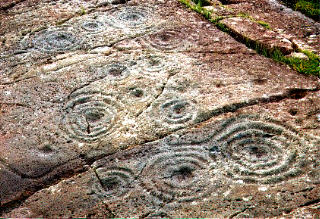
Cairnbaan 2 submitted by rockartuk on 19th Aug 2001. On the crossing of the A83 and B841 (to Crinan), behind The Cairnbaan Hotel, there is a signposted path leading to two panels with great Rock Art. This is site 2 (not fenced!). Beautiful combined carvings. Prehistoric loudspeakers; stock-still........
(View photo, vote or add a comment)
Log Text: Cairnbaan 2 Rock Art Panel: Leaving Cairnbaan 1 by its western corner, there’s a notice saying ‘further panels’. This was a little further than we thought, but very much worth the additional walk.
This second panel was truly magnificent, with its interlinked carvings. As the nice young couple from Huddersfield said: “A lovely one to finish on.”
We waited for the sun to come out to get the best contrast on the motifs. I really, really enjoyed seeing this panel.
As it was very hot, we decided to wander back through the forest slowly and make our way to Lochgilphead for refreshments. With only two more standing stones on the list to see, this almost concluded our Scottish visit.
St Mary's Well (Wreay)
Trip No.90 Entry No.1 Date Added: 31st Jul 2018
Site Type: Holy Well or Sacred Spring
Country: England (Cumbria)
Visited: Yes on 30th Jul 2018. My rating: Condition 3 Ambience 4 Access 4
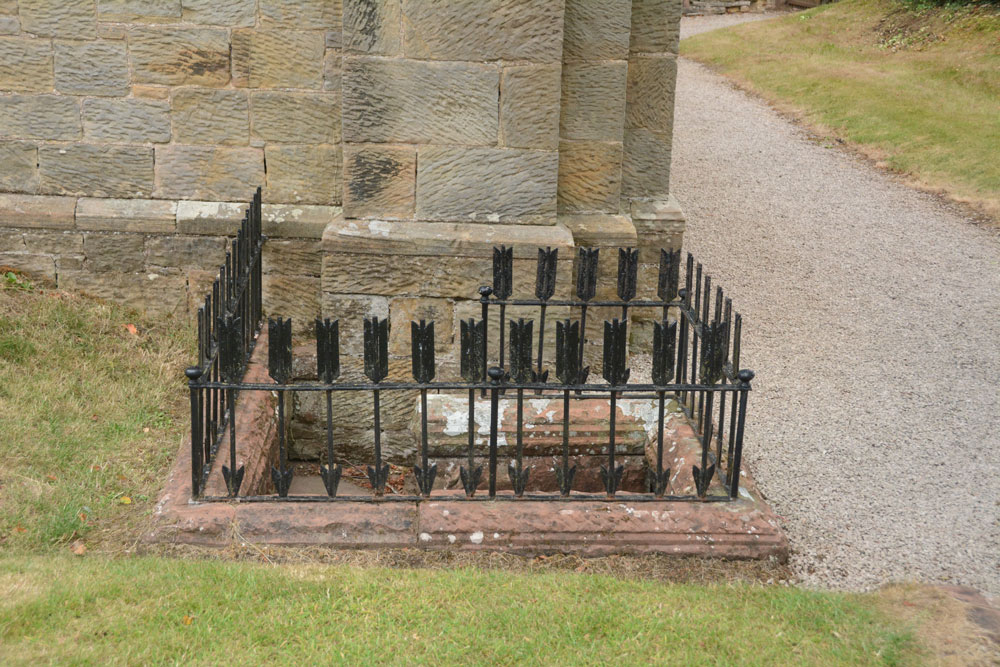
St Mary's Well (Wreay) submitted by Anne T on 31st Jul 2018. Approaching the well, with its curious railings made up of arrows, which represent 'death' according to the leaflets in the church.
(View photo, vote or add a comment)
Log Text: St Mary's Well and copy of the Bewcastle Cross, Wreay: This is a delightful little village, with some very old houses. The church is very easy to find, right in the middle of the village, opposite the colourful school, with plenty of parking on the streets nearby.
This well is to the southern side of the exterior western wall, although it has been dry for some considerable time. The well spout, in the form of an animal head, is quite superb and unusual (like the gargoyles on the roof line of the church).
The Holy Wells of Cumbria booklet (page 14) describes this well as:
Location: Approx. 9 miles south of Carlisle. The well is found by the front wall of St. Mary’s Church, Wreay.
Description: Although it is unknown whether this was a holy well, the highly unusual and attractive church is well worth a visit in itself. The original church dates back to 1319, and was rebuilt by Sarah Losh in 1840-42 – see also well 4 at Brisco – in memory of her sister Catherine and her parents. Italian in style, it is full of highly original and deeply symbolic carvings in wood and stone, many representing in forms from nature the eternal contrast between light and dark, or life and death. The well outside is a curious construction surrounded by cast iron arrows. Dog-leg stone steps lead down into the well, where water flows from a lion’s (or dog’s head) into a aquare stone piscina blessed with a solitary green fern and scattering of copper coins. The well (in 2008) was recently restored and is in excellent condition."
There was no water, no fern and no coins when we visited. Whilst the church, the sundial and the font in the churchyard are all scheduled, there is no mention of the well or the copy of the Bewcastle Cross. The church is indeed well worth looking inside. Andrew opened the door and said "I'm leaving you to go in first - it's scary!"
Cross House Incised Stone
Trip No.90 Entry No.2 Date Added: 31st Jul 2018
Site Type: Ancient Cross
Country: England (Cumbria)
Visited: Yes on 30th Jul 2018. My rating: Condition 3 Ambience 4 Access 4

Cross House Incised Stone submitted by Anne T on 31st Jul 2018. The inscribed stone, now mounted in a 19th century pillar. The age of the stone is unknown, but it is believed to be the remains of an old wayside or boundary cross.
(View photo, vote or add a comment)
Log Text: Cross House Incised Stone, Staffield: We parked at NY 53519 43219, where a gate lets you into the footpath which goes down the hill, and joins a second footpath to Chapel Well. We walked back up the hill towards Cross House. The pillar was just visible through the hedge. We let ourselves in to the field by the gate near Cross House (there was no-one around to ask) and quickly walked to the pillar to photograph the cross.
Interesting that HE classes this as a sanctuary cross, and Pastscape as a possible wayside or boundary cross.
On processing the photographs to post to the Portal this morning, I realised we’d been to this site in October 2015, but hadn’t submitted a new site or photos to the Portal. I had asked the lady hanging out her washing in the garden of Cross House and she’d given us permission to go into the field.
Splendid views south over to the River Eden and the site of the old priory. The pillar was very near the hedge, , but it was still possible to get photos of the recut stone in its 19th century pillar.
Chapel Well (Staffield)
Trip No.90 Entry No.3 Date Added: 31st Jul 2018
Site Type: Holy Well or Sacred Spring
Country: England (Cumbria)
Visited: Yes on 30th Jul 2018. My rating: Condition 3 Ambience 5 Access 4

Chapel Well (Staffield) submitted by Anne T on 31st Jul 2018. The well with its pond, taken from the western end. The water bubbled out of the ground just in front of the stone bowl at the time of our visit, and was a fair flow. Between the well pool and the 'pond proper' were some lovely clumps of irises. Certainly peaceful and restful.
(View photo, vote or add a comment)
Log Text: Chapel Well, Near Staffield, Cumbria: Not far from the incised stone at Cross House. We parked near the junction down the hill where there was room to bump up onto the grass verge and walked to the gate at NY 53603 43081, which is signposted towards ‘Dale’. We kept the dry stone wall to our right hand side, and as we approached the gate into the wood, a stone drinking trough and a tree with a ditch leading from it came into view. Slightly up the slope there were some red sandstone boulders on the horizon, with a sheep track leading up to it.
The drinking trough is at NY 53774 43194 and is similar to the ones we saw at Newbeggin. The tree with its accompanying ditch is at NY 53778 43244, and there are signs of another stone structure under the tree, now dry and ruined, but possibly a secondary outlet for the well during wet weather. At the bottom of the slope, a small hole leads through the stone wall into Croglin Water just beyond.
This well is certainly in a lovely spot, hidden in a dip towards the top of the slope. There were two ‘standing stones’, one on either side of the large well pool; the rest of the large boulders had been quarried and placed around the top of the pool. A circular well bowl can be seen at the top, centre of the well, and a good flow of water came from the well (not as much as Powdonnet Well). Half a sheep had been left to rot at the south eastern end of the pool, which spoilt the ambience, and stopped me from exploring the exit pipe, but taking that away, we could have lingered for a long while. Beautiful!
Bessygarth Well (King's Meaburn)
Trip No.90 Entry No.5 Date Added: 31st Jul 2018
Site Type: Holy Well or Sacred Spring
Country: England (Cumbria)
Visited: Yes on 30th Jul 2018. My rating: Condition 3 Ambience 4 Access 4
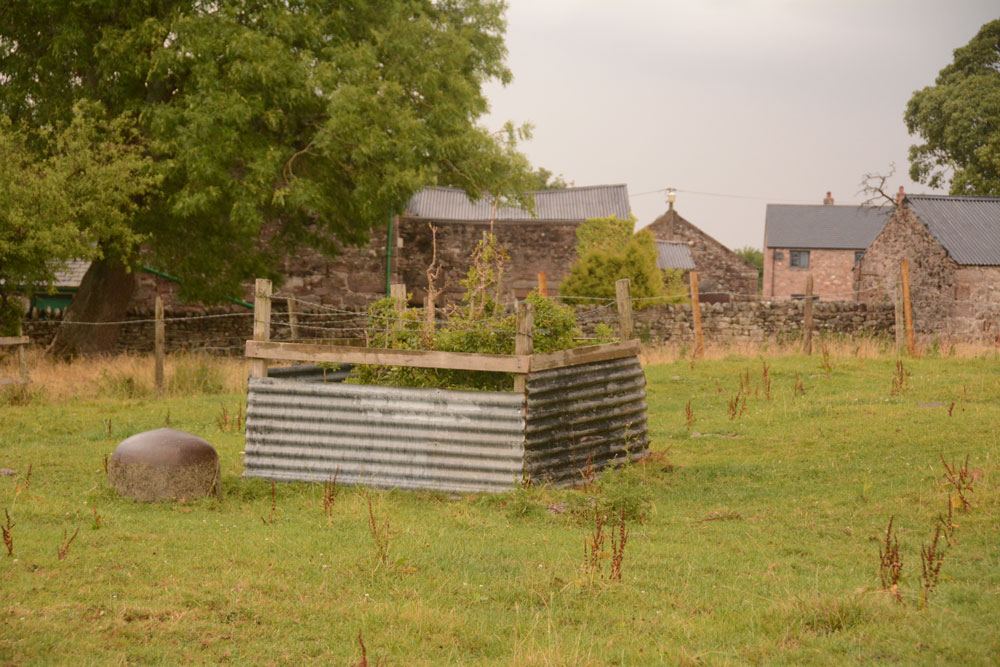
Bessygarth Well (King's Meaburn) submitted by Anne T on 31st Jul 2018. Getting closer, the peculiar cast iron 'bowl' (the cap for an old pump?) can be seen to the left hand side of the well. Thinking this was a drinking bucket for cattle/sheep, I tried to overturn it to look closer, only to find it was deeply embedded in the ground, and very heavily constructed.
(View photo, vote or add a comment)
Log Text: Bessygarth Well, King's Meaburn: This is a very old village, with a scheduled 17th century barn opposite the bus stop next to the village hall where we parked. The village runs in a long ribbon along both sides of the road, with an incongruous caravan park tucked behind the village hall.
Despite being marked on the OS map, we couldn’t find this well at first, so asked someone who’d pulled up outside one of the cottages opposite. He was only visiting, but was kind enough to ask inside the house, and relayed a message, saying that “if there’s some old tin in the field, that’s the well”. We were told it was OK to go into the field, providing we ensured the gate was shut.
Andrew dropped a stone down it, and it sounded deep! There was a most peculiar solid cast iron ‘bowl’ deeply embedded into the ground next to the well. Was this the cap of an old pump?
The field behind the well is covered in lumps and bumps. Researching it when I got home, found it was the site of the medieval settlement.
Chantry Well (Brigham)
Trip No.91 Entry No.6 Date Added: 18th Aug 2018
Site Type: Holy Well or Sacred Spring
Country: England (Cumbria)
Visited: Yes on 14th Aug 2018. My rating: Condition -1 Ambience 2
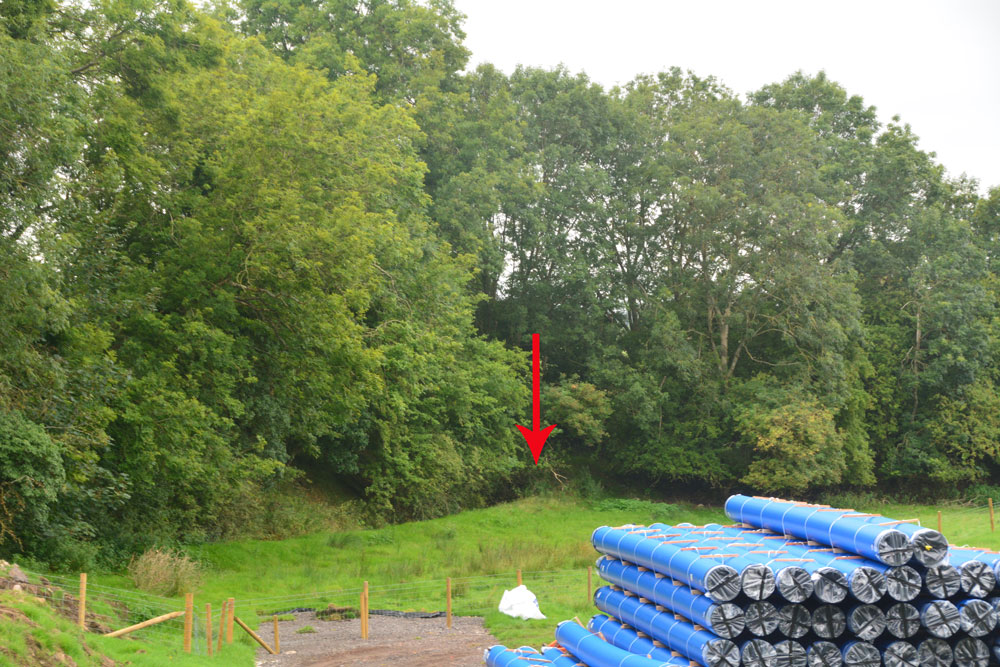
Chantry Well (Brigham) submitted by Anne T on 16th Aug 2018. This is the approximate site of the Chantry Well, as pointed out by the church warden of St. Bridgets, and as recorded by Pastscape Monument 9025 and the Old Cumbria Gazetteer. A new mains water pipeline is being driven through the field, although it was previously recorded the well was destroyed by quarrying. Some marshy ground still remains fenced off in the corner by the red arrow.
(View photo, vote or add a comment)
Log Text: Chantry Well, Brigham (Destroyed) The Reverend Mary told us there was a holy well at Brigham. There are actually 2 listed – Chantry Well and Nun’s Well, next to the A66.
Mr. Furness, the church warden also mentioned the well, but said it was no longer there. In the field opposite the church, a new water pipeline is being constructed. In the field to the south a new housing estate is also being built. There is no access into the field because of the building works, but the grid reference gives a point where the tree line bends.
St Bridget's Church (Brigham)
Trip No.91 Entry No.7 Date Added: 18th Aug 2018
Site Type: Ancient Cross
Country: England (Cumbria)
Visited: Yes on 14th Aug 2018. My rating: Condition 3 Ambience 4 Access 5
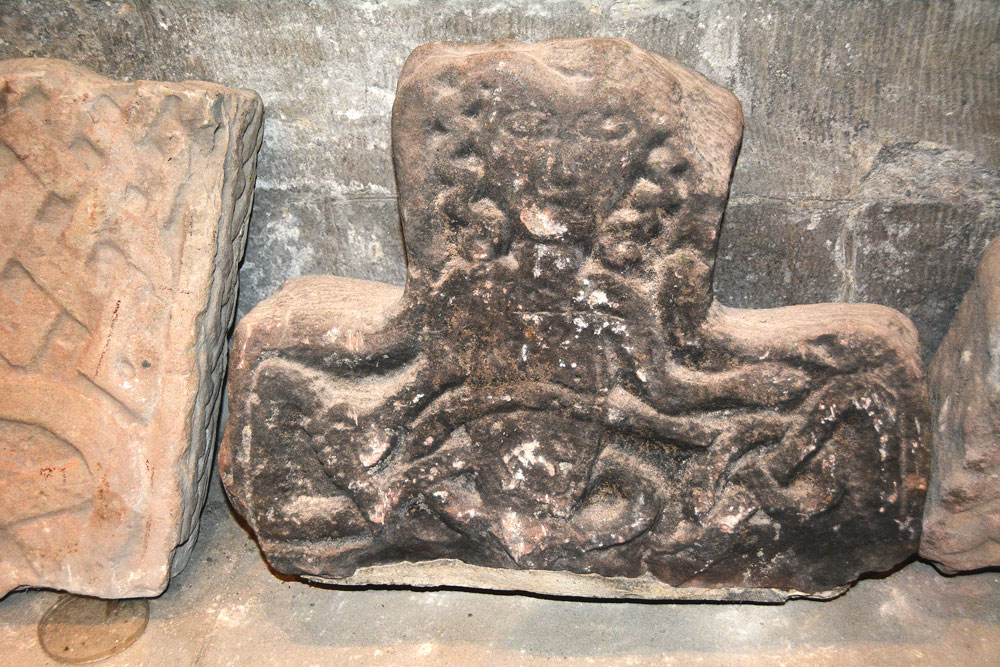
St Bridget's Church (Brigham) submitted by Anne T on 18th Aug 2018. This is Brigham 05, part of a cross-head dating to the 10th century. It was first recorded in 1881, presumed to have been found in restorations of 1864 or 1875-6. Note the curly haired naked figure, with his right hand and a snake (or interlace) bound across his stomach. His left hand is described as having an open palm, lying above the interlace of the right arm.
(View photo, vote or add a comment)
Log Text: St Bridget's, Brigham (Anglo Saxon Stones): Whilst this church looks very austere from outside, and the entrance doors dark and foreboding, once inside the church, it is a completely different picture – this church is light, airy and welcoming. The painted ceilings are fantastic.
The church warden turned up as arranged, and was so welcoming. He sought out a guide to the church and old postcards for information, then left me photographing the stones whilst Andrew walked round the church with him.
Time was all too short here, and I could have spent another hour, but we knew the church warden needed to get home, and the evening traffic was building up outside. In our haste, we missed Brigham 13, a cross base at the west end of the church (I thought I’d photographed it, as we went through all the AS Corpus pages I’d brought with me, but realised (too late) it wasn’t the correct stone).
After looking at the Fletcher family grave (now very worn and held together with large staples, I walked over to the west end of the churchyard to look at the farmhouse, which used to be the rectory for the farm).
We also looked for the site of Nun's Well, but were unable to see anything.
St Bridget's Church (Bridekirk)
Trip No.91 Entry No.5 Date Added: 18th Aug 2018
Site Type: Ancient Cross
Country: England (Cumbria)
Visited: Yes on 14th Aug 2018. My rating: Condition 3 Ambience 4 Access 5
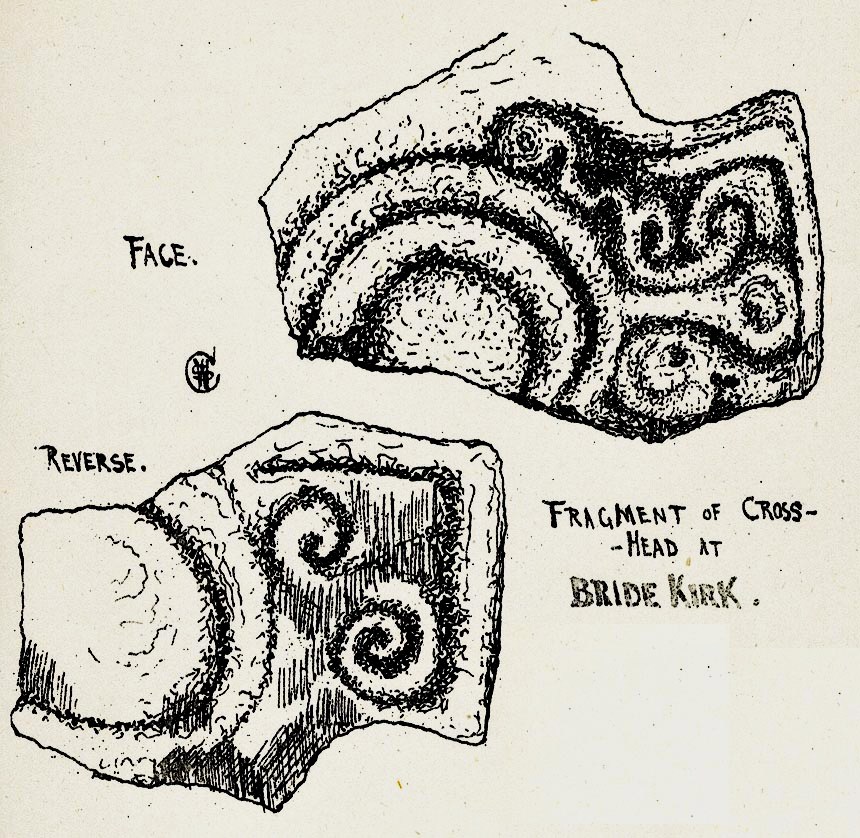
St Bridget's Church (Bridekirk) submitted by Sunny100 on 19th Apr 2011. Illustration of The Cross-Head fragment at St Bridget's Church, Bridekirk, Cumbria, by Rev William Slater Calverley 1847-98.
The above image is from his renowned work 'Early Sculptured Crosses, Shrines and Monuments in the Present Diocese of Carlisle 1899 Ed. by W.G. Collingwood.
(View photo, vote or add a comment)
Log Text: Font with Runic inscription, St. Bridget's, Bridekirk: We had an hour to fill between appointments between churches, so headed off to Bridekirk to see the font with runic inscription, which we'd missed during our last visit on 1st May 2015. The notice said the church was "normally open during daylight hours" but on this occasion the main door appeared to be bolted at the top from the inside, so we couldn't get in. This time, not having a six month old granddaughter with us, we walked round the outside of the church and noticed a collection of old grave slabs displayed against the exterior of the apse at the east end of the church, including an old cross base. None of these in mentioned on Pastscape.
Checking back in my photos, I had taken a photograph of the font. The middle band (when enlarged) does indeed have a runic inscription on it.
St Mungo's Church (Bromfield)
Trip No.91 Entry No.1 Date Added: 15th Aug 2018
Site Type: Ancient Cross
Country: England (Cumbria)
Visited: Yes on 14th Aug 2018. My rating: Condition 3 Ambience 4 Access 4

St Mungo's Church (Bromfield) submitted by Anne T on 10th Jul 2018. The dark red semi-circular stone is (the remains of) AS Corpus Bromfield 04, a 10th century hogback, as seen from the inside of the south porch. Located above the main door of the church, we stood for ages trying to make out the original hogback. The wavy edge at the top of this dark red sandstone is the only clue. According to the AS Corpus photos, the hogback can be better seen from inside the church, but the church was locked, so we were unable to see.
(View photo, vote or add a comment)
Log Text: St Mungo's Church, Bromfield: We'd arranged with the church warden for the church to be left open for us for an hour or so this morning, so this was our first stop on a 'five church stop' tour. We were looking forward to finding cross head and cross shaft fragments, and to being able to see the reverse side of the hogback stone above the doorway.
Whilst it looks quite daunting from the outside, the inside of the church is lovely, with some unique features, such as unusual corbels and the chancel arch, which is 'transitional between Norman and Gothic styles'.
I found the cemented remains of the cross head cemeted to the west end of the north aisle, and had to remove umbrellas and a carpet sweeper to see it. It was very cobwebby, and looked sadly neglected.
AS Corpus Bromfield 02 was in two pieces. There was a collection of old stones in the north transept, and we needed to move a low bench and a collection of chairs to be able to see this.
The hogback from the other side (inside the church) was much more convincing, and there was also a consecration cross on the right hand door jamb of the south door. Well worth returning to see.
St Mary's Church (Gilcrux)
Trip No.91 Entry No.2 Date Added: 16th Aug 2018
Site Type: Ancient Cross
Country: England (Cumbria)
Visited: Yes on 14th Aug 2018. My rating: Condition 3 Ambience 4 Access 5
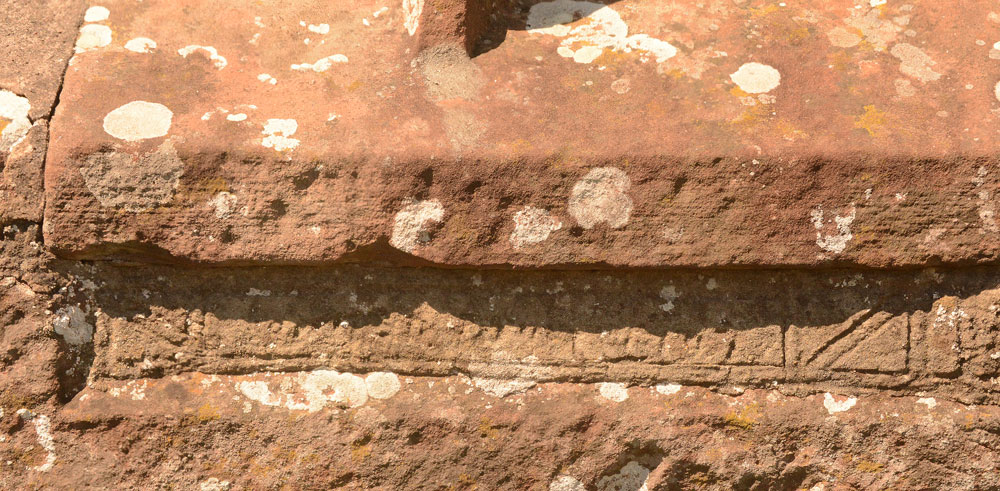
St Mary's Church (Gilcrux) submitted by Anne T on 10th Jul 2018. We may not have been able to see the Viking cross head and shaft fragment, but we did spot this underneath the window in the southern external wall of the sanctuary. The notes inside the church say it is the remains of a grave slab, recut for use as a lintel.
(View photo, vote or add a comment)
Log Text: St Mary's Church, Gilcrux: The little car park outside the church was full (3 cars and a Water Board van), so we had to park just west of the well and walk back to the church – only a little way. The church door was open for us this time.
This is a remarkable little church inside. At first site, the nave appears more like a Methodist chapel – at first glance. Then my gaze lit on the archway into the chancel, with a ‘squint’ over the right hand column and a chunk taken out of the eastern side of the left hand column. Walking into the chancel is very reminiscent of Escombe Saxon Church – this place is ancient and very peaceful.
The collection of stones was underneath a table against the south wall, near the porch, so we turned into furniture removers, carefully taking the notice board, vases and loose notices off the table, then moving the table to examine and photograph the pieces.
We managed to put together the pieces of the cross head and part of the shaft, and photographed two sides. One of the pieces left white, chalky marks on our hands, and is very white against the grey of the other two pieces. This is clearly the cast of the upper part of the cross head.
We closed the church door to indicate to the keyholder we’d been in and left again, and walked round to the north side of the church, where it is very obvious that the church has been built on a mound.
There was no church guide book, but there were some ‘notes for visitors’ which I photographed, and have typed into my walk journal.
The spring was in full flow, and it was lovely to hear it babbling away. Brilliant. Definitely worth a return visit.
St Mungo's Dearham
Trip No.91 Entry No.4 Date Added: 16th Aug 2018
Site Type: Ancient Cross
Country: England (Cumbria)
Visited: Yes on 14th Aug 2018. My rating: Condition 3 Ambience 4 Access 5
St Mungo's Dearham submitted by coin on 29th Mar 2017. The Viking Cross at Dearham
(View photo, vote or add a comment)
Log Text: St Mungo's Church, Dearham: AS Corpus Dearham 03 and The Adam Stone: This was a return visit. pre-arranged with the lovely Reverend Mary, who drove from Crosscanonby to very kindly unlock the door of the vestry to show us AS Corpus Dearham 03, part of a cross-head.
We also saw the Adam Stone. Mary moved the knitted figures of Jesus and Peter and invited me to climb on the pew to get a better photograph. We felt so welcome, we didn’t really want to leave!
St John The Evangelist (Crosscanonby)
Trip No.91 Entry No.3 Date Added: 17th Aug 2018
Site Type: Ancient Cross
Country: England (Cumbria)
Visited: Yes on 14th Aug 2018. My rating: Condition 3 Ambience 4 Access 5
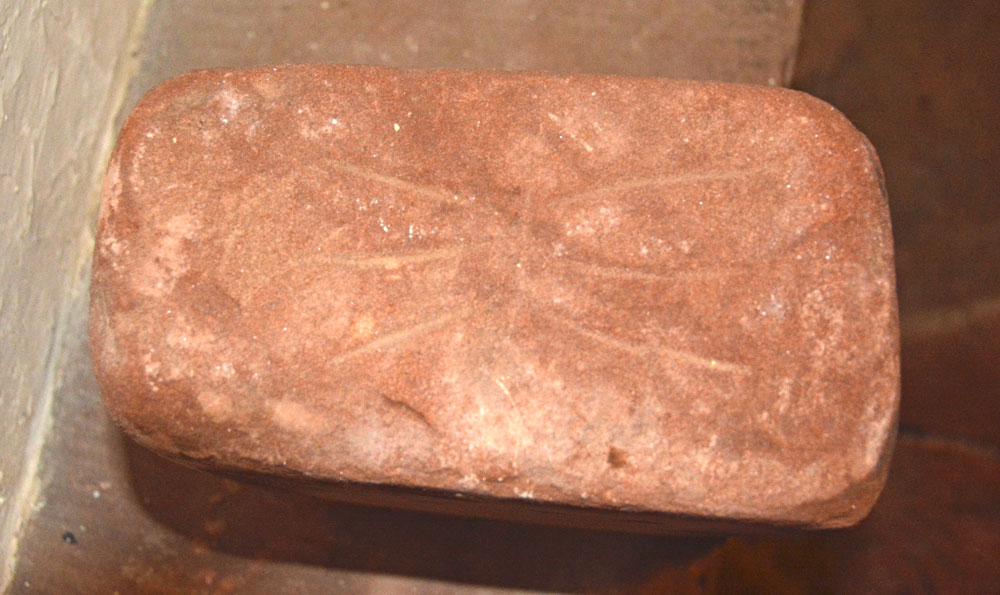
St John The Evangelist (Crosscanonby) submitted by Anne T on 17th Aug 2018. Face D of AS Corpus Cross Canonby 03, also known as The Thunder Bolt Stone. The Corpus tells us this face shows: "the incised ornament consisting of a single horizontal line on which converge three incised lines from above and below." This is the famous 'thunder bolt' symbol.
(View photo, vote or add a comment)
Log Text: St John The Evangelist, Crosscanonby: We had arranged to meet the Reverend Mary at the church at 2pm. Between Gilcrux and here we had an hour to spare, so went into Cockermouth for lunch and a quick walk round the town. Travelling through Dearham and across the A596 to Crosscanonby, as we dropped down a small hill after having crossed the A596, we realised how close this church is to the Solway Firth (according to UK Grid Finder measurements its 900m).
This little church is side on to the road, and is virtually invisible until you reach the gate into the churchyard, although the ‘this church is open’ board gave something away.
I’d not looked at the AS Corpus notes I’d brought, but straight away we spotted the hogback against the south eastern corner of the nave.
Walking inside was a real treat. This is clearly a very old building. Reverend Mary (just ‘Mary’ she said) told us this church used to be the mother church for Maryport and the farm house next door (to the west of the church) used to be part of the monastery; the monks used to process from the monastery to the church; rumour has it there is a tunnel from the farmhouse to the church, but it’s never been found.
The church is pretty special, although I focussed on photographing the stones in the porch whilst Andrew spoke to Mary about the structure of the building, as I was conscious of taking up Mary’s time and we needed her to come across to Dearham to open the vestry for us. I’d love to go back and spend more time here.
St Mungo's Well (Cumbria)
Trip No.91 Entry No.8 Date Added: 18th Aug 2018
Site Type: Holy Well or Sacred Spring
Country: England (Cumbria)
Visited: Yes on 14th Aug 2018. My rating: Condition 3 Ambience 4 Access 4
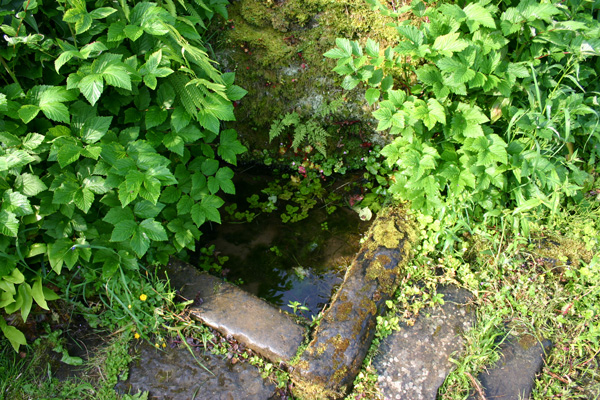
St Mungo's Well (Cumbria) submitted by ocifant on 26th Jun 2005. Looking at the various maps, the location of this well is difficult to discern. It's actually easy to find once you get to the church though.
From St Kentigern's in Caldbeck, walk through the churchyard from the road, and exit via the rear gate. Cross the footpath to the river. Immediately on entering the river path, there are a couple of steps down to the riverbank. These lead to the well.
(View photo, vote or add a comment)
Log Text: St Kentigern's Well, Caldbeck: This was our last stop of the day, and to a part of Cumbria we've never travelled through before. From St. Bridget's in Brigham, we followed the B5299 to Caldbeck village, which took us over cattle grids and moorlands, with only sheep and the occasional other car in sight.
Caldbeck is a really pretty little village, and we resolved to come back during the daytime, when the shops, church and café were open.
The well can be easily found by walking down the footpath to the west of the church, until you get to the bridge over the river. As it says in the "Holy Wells of Cumbria" booklet, turn left just before the bridge, and you immediately come to some steps down the (steep-ish) bank to the river. We heard the trickle of water down the slope, and the well basin comes into view as you look down. At the time of our visit the water missed the basin and was trickling down the rock, under the shrubbery, into the river. There was a fair flow of water coming down the bank.
We walked along the footpath along the northern side of the churchyard for about 100mand found a lovely weir with small waterfalls. It was possible to walk down to the gravel beach. A lovely spot indeed.
Glennan Standing Stone
Trip No.83 Entry No.3 Date Added: 1st Aug 2018
Site Type: Standing Stone (Menhir)
Country: Scotland (Argyll)
Visited: Yes on 18th Aug 2018. My rating: Condition 3 Ambience 5 Access 4
Glennan Standing Stone submitted by cosmic on 29th Aug 2003. Glennan Standing Stone.
(View photo, vote or add a comment)
Log Text: Glennan Standing Stones and Cairns: What could top Kintraw Standing Stones & Cairns? But we found places that almost did. Carrying on down the A816 towards Kilmartin, we turned east on the road towards the small village of Ford, travelling along a very beautiful valley. We stopped at Old Glennan farmhouse (pulled into the gateway to the track up to the house, which looked as if it hadn’t been used in ages, and was in sight of the stone). Letting ourselves in through the gate, we followed the track up, with the line of an old stone wall, now only ankle height, up to where it turned a corner, just to the north of the house. The stone appeared to be incorporated into a taller part of the wall.
Walking back to the car, I spotted what looked like a cairn with a slight ditch around it. Andrew looked up the Canmore reference on his phone and determined there were two cairns near the gate, one much reduced. According to Canmore there is a cup marked stone on one, although both cairns were well grassed over at the time of our visit.
Creagantairbh Beag
Trip No.88 Entry No.5 Date Added: 1st Aug 2018
Site Type: Standing Stone (Menhir)
Country: Scotland (Argyll)
Visited: Yes on 18th Aug 2018. My rating: Condition 3 Ambience 4 Access 4

Creagantairbh Beag submitted by hamish on 2nd Apr 2002. Creagantairbh Beag
NM859015
Map 55.
Found off the B840 Loch Awe road about 2 miles from the junction with the A816.On the map it is called Creganterve Beg.
(View photo, vote or add a comment)
Log Text: Creagantairbh Beag Standing Stone: I hadn’t spotted these on the OS map as we were driving along, but saw the still standing stone through the fence line. Quickly stopping by the side of the road to take a photograph, I noticed there was also a fallen stone. We decided to stop and investigate further on the way back down the road from Ford village.
On way back from Ford, we turnedthe car onto a track signposted to ‘Kilmichael Glen 7’ we were immediately into the same field as the standing stones(s), only on the right side of the fence. Getting closer we realised that the cracks on both sides of the stone matched almost precisely, so the fallen part must have been the top of the stump. This would have been amazingly tall!
In the field of the house opposite were some brown and black alpacas, and I took a photo to remind me.
Ford Cist
Trip No.88 Entry No.6 Date Added: 1st Aug 2018
Site Type: Cist
Country: Scotland (Argyll)
Visited: Yes on 18th Aug 2018. My rating: Condition 2 Ambience 2 Access 5
Ford Cist submitted by caradoc68 on 20th Feb 2012. Very easy to get to being on the Ford cross roads, with a bus stop within feet of this monument.
(View photo, vote or add a comment)
Log Text: Ford Cist: Not having access to the internet, we thought this was just a cairn which had been marked on the OS map. This monument is in an odd location, just inside the village boundary, tucked between the junction of the road through to Torran and the B840 running along the south shore of Loch Awe, opposite the Crown Hotel and next to a bus stop. Tis mound was fenced off, with no means of accessing the area (apart from climbing the fence) and no information board.
We took some photographs of the mound, but didn’t climb the slope, as we were keen to see the cross-inscribed standing stone at Torran and didn’t know if we’d find it, plus we’d seen another standing stone is a field to the west of the road just before we entered the village and wanted to make time to explore that. The cist was just to the south of a babbling River Ford and a small road bridge over the river.
Brandy Well (Great Whittingham)
Trip No.92 Entry No.1 Date Added: 21st Aug 2018
Site Type: Holy Well or Sacred Spring
Country: England (Northumberland)
Visited: Yes on 21st Aug 2018. My rating: Condition 3 Ambience 4 Access 4
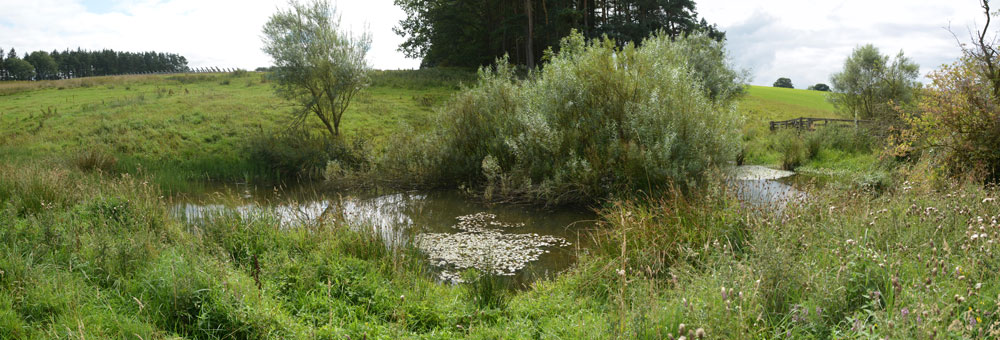
Brandy Well (Great Whittingham) submitted by Anne T on 21st Aug 2018. This panorama of the well pool is taken from just over the wooden footbridge at its north western side. A very peaceful, lovely spot.
(View photo, vote or add a comment)
Log Text: Brandy Well, Todridge Farm, near Great Whittingham: We decided to stop off here on our way to Carlisle to look for this unusually named holy well, near The Queens Arms pub/Chinese restaurant we’ve been to several times. We parked at NY 99652 71590, on the verge before the entrance to Todridge Farm. The farm is more than just a farmhouse and a barn – it’s a hamlet with a number of houses.
Following the track to NY 99143 71795, there is gate into the field on the right hand side (the footpath sign has worn away, it’s just a small white plaque), and we followed this diagonally across the field to the end of the wood, passing a small solar energy ‘farm’ to our right hand side. At about NY 99084 71982 there is a small wooden gate with a footpath sign on it, but this was firmly tied up with a number of ropes (the hinges had broken), so we used the larger gate into the field, and walked a few tens of metres down the slope to the bridge.
On the bridge, you can hear water trickling at the edge of the pool; looking down, there is a dam which lets water out into the stream beyond. Having photographed the well pool from the bridge, we walked up to the land bridge/tractor track at NY 99134 71998 and turned left towards the northern side of the pool. There, in the corner of the fence, we could see the remains of a stone structure, now fallen into what looked like an extension to the pond, where people used to pull water out of.
This is a very pretty spot and a very pretty, if now overgrown, pond, full of waterlilies.
Todley Hill Mound (Great Whittingham)
Trip No.92 Entry No.2 Date Added: 21st Aug 2018
Site Type: Misc. Earthwork
Country: England (Northamptonshire)
Visited: Yes on 21st Aug 2018. My rating: Condition 3 Ambience 4 Access 4

Todley Hill Mound (Great Whittingham) submitted by Anne T on 21st Aug 2018. Standing by the small ford across the stream to the north of the mound, looking south as the mound rises high above us.
(View photo, vote or add a comment)
Log Text: Todley Hill Mound, near Great Whittingham: Walking back to the car, we saw a couple of vans with trailers belonging to the farmers, and I was looking for someone to ask permission to enter the field to see the mound, but whilst the trailer doors were left wide open, no people were visible. There was a gate into the field at NY 99675 71602, almost opposite where we’d parked the car, but there was a stream in the way. We opted to drive further back up the road, and parked at NY 99488 71218, where the road widens out into a large field entrance and dump for roadstone.
The gate into the field had been chained shut, so we walked back down the road and found part of the fence we could hop over.
This is a large mound, in a pretty spot with a small stream to its northern side. There appeared to be a large earth-fast boulder towards its south western side, with smaller boulders surrounding it, but the latter had been broken and were probably field clearance.
Walking round the mound, it appeared to us to have vague traces of a kerb with boulders/stones poking through, mainly on its southern and eastern sides.
This mound/tumulus/barrow is right on the old Roman Road, the Devil’s Causeway, jus to the east of where this cuts the modern road. The vague remains of an edge of this road can be seen (possibly) in the field opposite, to the south of the small stream (or it maybe modern uplift from dredging the stream).
This really had the feel of a barrow to me, and I enjoyed walking round it.
Hawthornside Farm (Bonchester Bridge)
Trip No.93 Entry No.1 Date Added: 31st Aug 2018
Site Type: Holy Well or Sacred Spring
Country: Scotland (Scottish Borders)
Visited: Yes on 29th Aug 2018. My rating: Condition 3 Ambience 3 Access 5
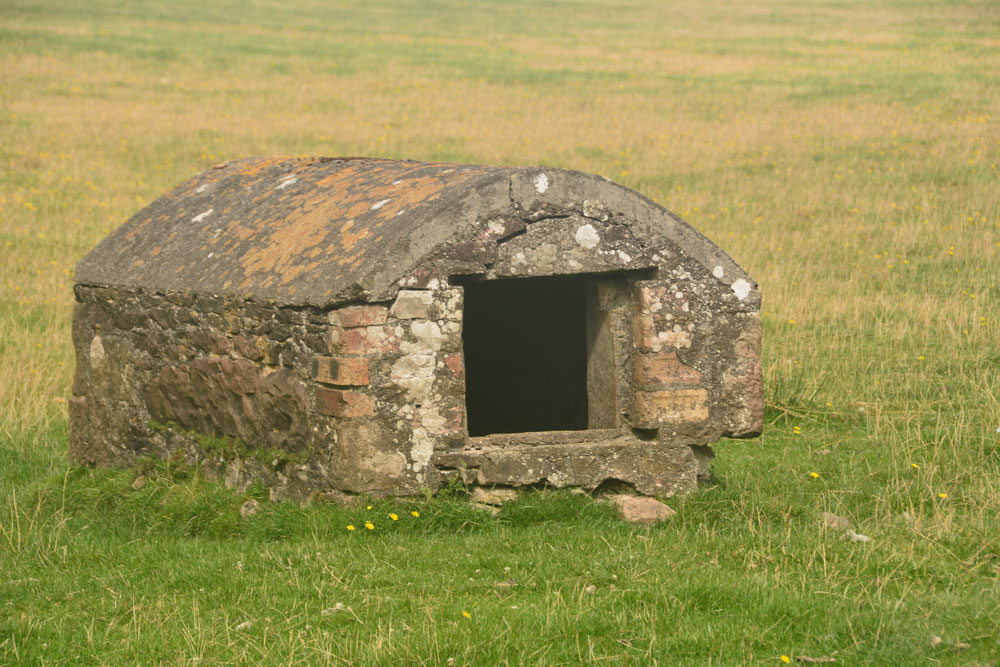
Hawthornside Farm (Bonchester Bridge) submitted by Anne T on 31st Aug 2018. This 'well house' is marked as a tank on the Canmore map, although the structure looks old and the chamber holds clear water. I'd love to know more about this well/tank if anyone has any information. We spotted it by chance trying to find our way to Bedrule.
(View photo, vote or add a comment)
Log Text: Well/tank, Hawthornside Farm (Bonchester Bridge): We spotted this ‘well house’ purely by chance as we passed by, then needing to turn the car round to go to Bedrule Church with its hogback fragments. This is a lovely site, right by the A6088. The well house (or ‘sink’ as it is labelled on the Canmore map) has Rubers Law Hillfort in the background.
There is no mention of Canmore, apart from the word ‘tank’ on its large scale map. The water appears to come straight up into the well basin – there is no sign of a pipe in or out. It does have the hinges for a (presumably wooden) door, which is no longer there. The water was beautifully clear and the inside of the structure clean.
